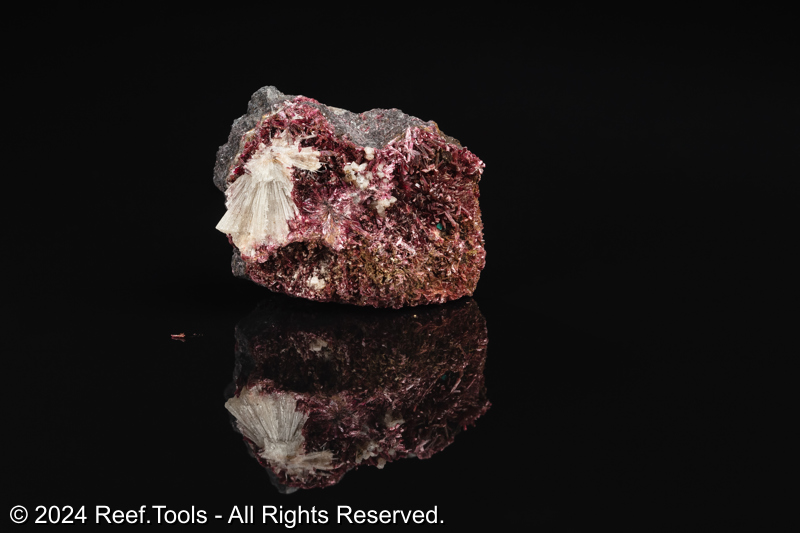
Cobalt (Co)
Transition Metals
Atomic Number: 27
Last Reviewed: 12/15/2024
Cobalt (Co) is a trace element present in marine environments, playing a crucial role in various biological processes within reef aquariums. Understanding its functions, optimal concentrations, and management is essential for maintaining a healthy and balanced reef system.
Primarily known for its role as a central component of vitamin B₁₂ (cobalamin). In reef aquariums, cobalt supports the metabolic activities of corals and other marine organisms, contributing to overall health and vitality.
Natural Seawater Levels
Cobalt concentrations in natural seawater are extremely low, typically around 0.03 µg/L. Oceamo
Risks
- Deficiency: While specific deficiency symptoms in corals are not well-documented, insufficient cobalt may impair vitamin B12 synthesis, potentially affecting metabolic functions.
- Excess: Elevated cobalt levels can be detrimental, promoting the growth of cyanobacteria and causing coral tissue darkening. High concentrations may also encourage the proliferation of certain dinoflagellate species.
Relevancy
Vitamin B12 Synthesis: Cobalt is integral to the structure of vitamin B12, which is synthesized by symbiotic bacteria in coral mucus. This vitamin is vital for various metabolic processes in marine life.
Enzymatic Functions: As a cofactor, cobalt is involved in enzymatic processes related to nitrogen fixation and amino acid synthesis, supporting coral growth and resilience.
Ocean Values
| Reference Name | Low | High | Optimal | Unit |
|---|---|---|---|---|
| Florida Ocean | 0.0100 | 0.0500 | 0.0300 | µg/L |
| Fiji Ocean (Generic) | 0.0100 | 0.0500 | 0.0300 | µg/L |
| Australia Ocean(Generic) | 0.0100 | 0.1000 | 0.0500 | µg/L |
Regional Variations
Cobalt concentrations can vary based on factors such as proximity to terrestrial inputs and local biogeochemical processes.
Dosage Recommendations
Target Level: Maintain cobalt concentrations at approximately 0.03 µg/L, consistent with natural seawater levels.
Supplementation: If necessary, follow manufacturer guidelines and adjust based on accurate testing to avoid overdosage.
Handling
Testing: Utilize precise analytical techniques for monitoring cobalt levels, acknowledging the limitations of standard aquarium test kits.
Supplementation: Only consider supplementation if a verified deficiency exists, and proceed with caution to prevent toxicity.
Reef.Tools recommends: Maintain Cobalt (Co) concentrations between 0.0100 and 0.0500 µg/L.
References
- Sunda, W. G., & Huntsman, S. A. (1995). Cobalt and Zinc Interreplacement in Marine Phytoplankton. Limnology and Oceanography.ASLO
- Bruland, K. W. (1983). Trace Elements in Seawater. In Chemical Oceanography (Vol. 8). Academic Press.
- Paerl, H. W., & Otten, T. G. (2014). Harmful Cyanobacterial Blooms: Causes, Consequences, and Controls. Microbial Ecology.
- Intergovernmental Oceanographic Commission (IOC) Reports on Trace Elements in Seawater. (IOC-UNESCO)
Difficulty
Rating: Moderate
Managing cobalt levels is moderately challenging due to its ultra-trace concentration in seawater and the potential for adverse effects if levels are not properly controlled.
Categorization
Element Type: Trace Element
Role: Vitamin B12 Component, Enzymatic Cofactor
Not Usually Deficient
Cobalt is typically present in sufficient amounts in reef aquariums, especially with regular water changes and quality salt mixes. Deficiencies are uncommon due to natural replenishment through water changes and the presence of cobalt in various aquarium inputs.
Essential
Cobalt is essential for the synthesis of vitamin B12 and the proper functioning of certain enzymes in marine organisms. Its role in critical metabolic processes underscores its necessity in reef aquariums.
Aliases
Co, Cobalamin (Vitamin B₁₂)